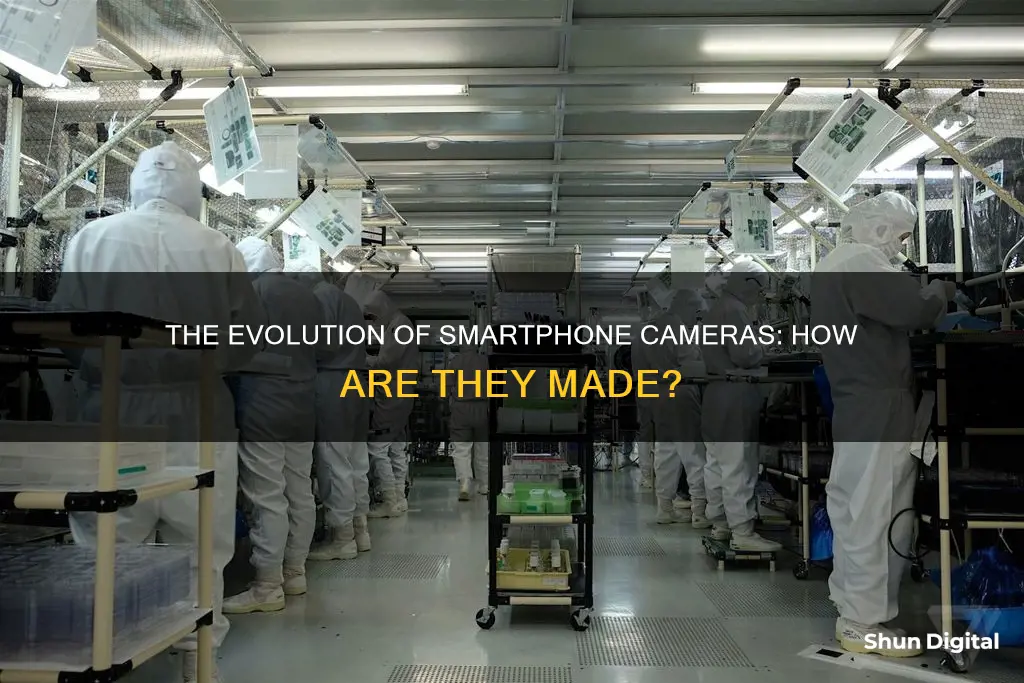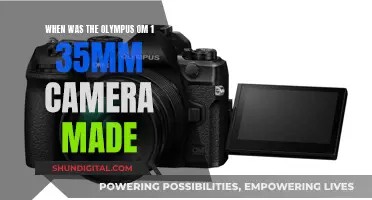
Smartphone cameras have come a long way since the first cellphone with a camera was introduced in 2002. Today, smartphone cameras are made up of several components, including the lens, sensor, image signal processor (ISP), and in some cases, a Time-of-Flight (ToF) sensor. The lens is typically made of plastic or glass and is responsible for focusing light onto the image sensor. The sensor, a sophisticated piece of technology, converts the light into electrical signals, with each pixel capturing a specific colour. The ISP then processes these signals, applying corrections and enhancements to create the final image. In addition, some smartphones use ToF sensors to measure the depth of a scene, improving focus and enabling augmented reality applications.
What You'll Learn
- Lenses: Made of glass or plastic, they focus light on the camera sensor
- Sensors: Converts light into electrical signals, with higher megapixels capturing more detail
- Image Signal Processors (ISP): The 'brain' of the camera, converting signals into viewable images
- Aperture: Controls the amount of light entering the lens, affecting photo brightness
- Focal Length: Determines the field of view, or how wide/narrow the photo will be

Lenses: Made of glass or plastic, they focus light on the camera sensor
Lenses are an essential component of smartphone cameras, serving the critical function of focusing light onto the camera sensor to form an image. These lenses are typically crafted from transparent materials such as glass or plastic, with each material offering distinct advantages and considerations.
In the early days of smartphone cameras, glass was the predominant material for lenses. However, as smartphone cameras evolved and advanced, plastic lenses emerged as the material of choice for several reasons. Plastic lenses are lightweight, making them ideal for small form factor cameras in smartphones that strive for thin designs. Additionally, plastic lenses can be mass-produced at a low cost, which is crucial for the high-volume manufacturing of smartphones. The use of injection-molded plastic allows for the creation of complex, high-resolution lens elements that can be crammed into the limited space within a smartphone.
Despite the advantages of plastic lenses, glass lenses still hold relevance. Glass offers superior refractive properties compared to plastic, and certain smartphone manufacturers, such as Sony with its Xperia Pro-i, continue to utilise glass lenses to achieve exceptional image quality.
The design of smartphone camera lenses involves a series of convex and concave lenses with varying densities. These lenses work in tandem to direct light through to the sensor, ensuring that the captured image is as accurate and sharp as possible. The precise positioning and quality of these lens elements are critical to avoiding issues such as chromatic aberration, blurring, and reduced contrast.
The radius of curvature of the lens surfaces plays a pivotal role in how light is refracted. Lenses with a bulge in the centre that curves outwards are known as convex lenses, while those that curve inwards are concave lenses. Convex lenses are converging lenses, causing light to bend inward toward a focal plane. On the other hand, concave lenses diverge or spread light outwards.
The focal length of a lens also impacts the image captured. A shorter focal length yields a wider angle of view, capturing more of the scene. Conversely, a longer focal length results in a more magnified and narrow angle of view.
In summary, lenses are a fundamental component of smartphone cameras, and their design and material composition significantly influence the overall image quality. The transition from glass to plastic lenses in smartphone cameras has been a notable development, driven by the need for compact, lightweight, and cost-effective solutions that can deliver sharp images within the confines of a thin smartphone design.
Understanding Shutter Priority Mode: Creative Control for Photographers
You may want to see also

Sensors: Converts light into electrical signals, with higher megapixels capturing more detail
The sensor is one of the most advanced parts of a smartphone camera. It is responsible for converting light into electrical signals, a process known as photovoltaic conversion. This is done through millions of photosites, or pixels, across the sensor's tiny surface. When photons of light hit these photosites, they are converted into electrons (electrical signals). The number of photosites on a sensor determines the megapixel count of the camera.
The size of the photosites impacts the amount of light they can capture, with larger photosites able to gather more light, making them better suited for low-light conditions. This is why a smartphone camera with a higher megapixel count may not necessarily perform better than one with lower megapixels, as it depends on the size of the individual photosites. For example, a 64MP sensor with 0.8µm pixels may not perform as well as a 12MP sensor with 2.4µm pixels.
The sensor size also plays a role in image quality. A bigger sensor typically produces better images as it has more and larger photosites. The size of the sensor is measured in fractions of an inch, with some sensors being as large as 1/1.31-inch, like the one found in the Google Pixel 7 Pro.
The number of shades of gray the sensor can register is known as its bit depth. By using a colour filter array, such as the Bayer colour filter array, each photosite captures a specific colour of light (red, green, or blue). This colour data, along with the electrical signals from the sensor, is then processed by the image signal processor (ISP) to create a full-colour image.
The technical specifications of the sensor, such as its size and megapixel count, are essential in determining the overall performance and quality of a smartphone camera. Manufacturers are constantly innovating to improve sensor technology, such as Sony's back-illuminated CMOS image sensor, which expands the volume of light that enters a unit pixel, resulting in higher image quality and lower noise compared to conventional sensors.
Charging the Fredi Camera: A Step-by-Step Guide
You may want to see also

Image Signal Processors (ISP): The 'brain' of the camera, converting signals into viewable images
Image Signal Processors (ISPs) are the brain of the camera, converting signals into viewable images. They are a type of media processor or specialised digital signal processor (DSP) used for image processing in digital cameras or other devices. ISPs perform a range of tasks, including HDR correction, colour correction, damaged pixel repair, and AI correction to improve image quality.
The ISP receives data from the image sensor in the form of a black-and-white image, which it then processes to bring back the colour data based on the known arrangement of the colour filter array. The ISP modifies the pixel colours based on the colours of its neighbours, using a demosaicing algorithm to produce an appropriate colour and brightness value for each pixel. It also assesses the whole image to guess the correct distribution of contrast, making tonal gradations more realistic.
The ISP also works to separate noise from the image information and remove it. This can be challenging, as the image may contain areas of fine texture that could lose definition if treated as noise. After demosaicing, the ISP typically applies denoising and sharpening. Every OEM has its own pipeline and algorithms for producing the final image.
In addition to image processing, ISPs can also perform functions such as face recognition and automatic scene recognition. They are an essential component of smartphone cameras, enabling a wide range of image quality adjustments and improvements.
Understanding Your Camera's Metering Modes
You may want to see also

Aperture: Controls the amount of light entering the lens, affecting photo brightness
Aperture is a crucial setting in photography, controlling the amount of light that reaches the camera's sensor. It is one of the three pillars of photography, alongside shutter speed and ISO.
The aperture of a lens is the opening through which light passes into the camera. The wider the opening, the more light can reach the camera sensor, affecting the brightness of the resulting image. Just like the pupil of the human eye, the aperture needs to increase or decrease in size to achieve the correct exposure depending on the lighting conditions. This adjustment is made by an array of aperture blades in the lens that synchronously move to change the aperture size.
Aperture is expressed in f-stops, which are ratios of the focal length divided by the opening size. A lower f-number denotes a larger aperture, allowing more light to reach the sensor and resulting in better low-light performance. Conversely, a higher f-number indicates a smaller aperture, reducing the amount of light that passes through.
In smartphone cameras, the aperture is placed at the entrance of the lens and moves with it. As smartphone cameras have evolved to incorporate larger image sensors, the trend has been towards wider lenses with larger apertures to facilitate greater light absorption and enhance low-light image quality. This design choice, however, can lead to compromises in picture and video quality in well-lit environments.
The aperture setting not only affects the brightness of an image but also influences the depth of field. A smaller aperture increases the depth of field, resulting in a sharper image with more of the scene in focus. On the other hand, a larger aperture creates a shallower depth of field, producing a blurred background and emphasising the subject in the foreground.
By controlling the aperture, photographers can creatively manipulate the amount of light entering the lens, thereby affecting photo brightness and depth of field to capture their desired image.
Mastering Vignette Effects in Camera Raw
You may want to see also

Focal Length: Determines the field of view, or how wide/narrow the photo will be
The focal length of a smartphone camera determines the field of view, or how wide or narrow the resulting photograph will be. In other words, it dictates the angle of view, which is the angle between two lines drawn out from the nodal point to the outer edge of the lens's field of view.
A longer focal length results in a narrower field of view, capturing a smaller area of the scene. Conversely, a shorter focal length provides a wider field of view, capturing a broader vista. For example, the Samsung Galaxy S20 Ultra's primary camera has a focal length of 25mm, resulting in a wider field of view compared to its telephoto lens, which is set to 103mm.
The focal length also affects the magnification of the image. In most photography and all telescopy, where the subject is essentially infinitely far away, a longer focal length leads to higher magnification and a narrower angle of view. Conversely, a shorter focal length results in lower magnification and a wider angle of view.
It's important to note that the focal length of a smartphone camera is fixed, which is why some phones have multiple lenses for wide, ultra-wide, and telephoto shots. Additionally, the maximum aperture also impacts the field of view, as it determines how much light reaches the sensor, influencing the depth of field.
Focal length is a crucial aspect of lens design and plays a significant role in determining the resulting photograph's field of view and magnification.
Understanding Camera Raw's Unique Circular Slider
You may want to see also
Frequently asked questions
The basic components of a smartphone camera are the lens, the sensor, and the software.
The lens focuses light onto the camera sensor. The lens is usually made of plastic or glass and is the only part of the camera that is visible to the user.
The sensor is a light-sensitive semiconductor that converts light into an electrical signal. It is made up of millions of light-sensitive spots or pixels, each with a red, green, or blue color filter.
The software converts the electrical signals from the sensor into a digital image that can be viewed, edited, and shared.
Yes, some smartphone cameras may include a Time-of-Flight (ToF) sensor, which emits an infrared laser to measure the depth of a scene, enabling better focus and augmented reality applications.







